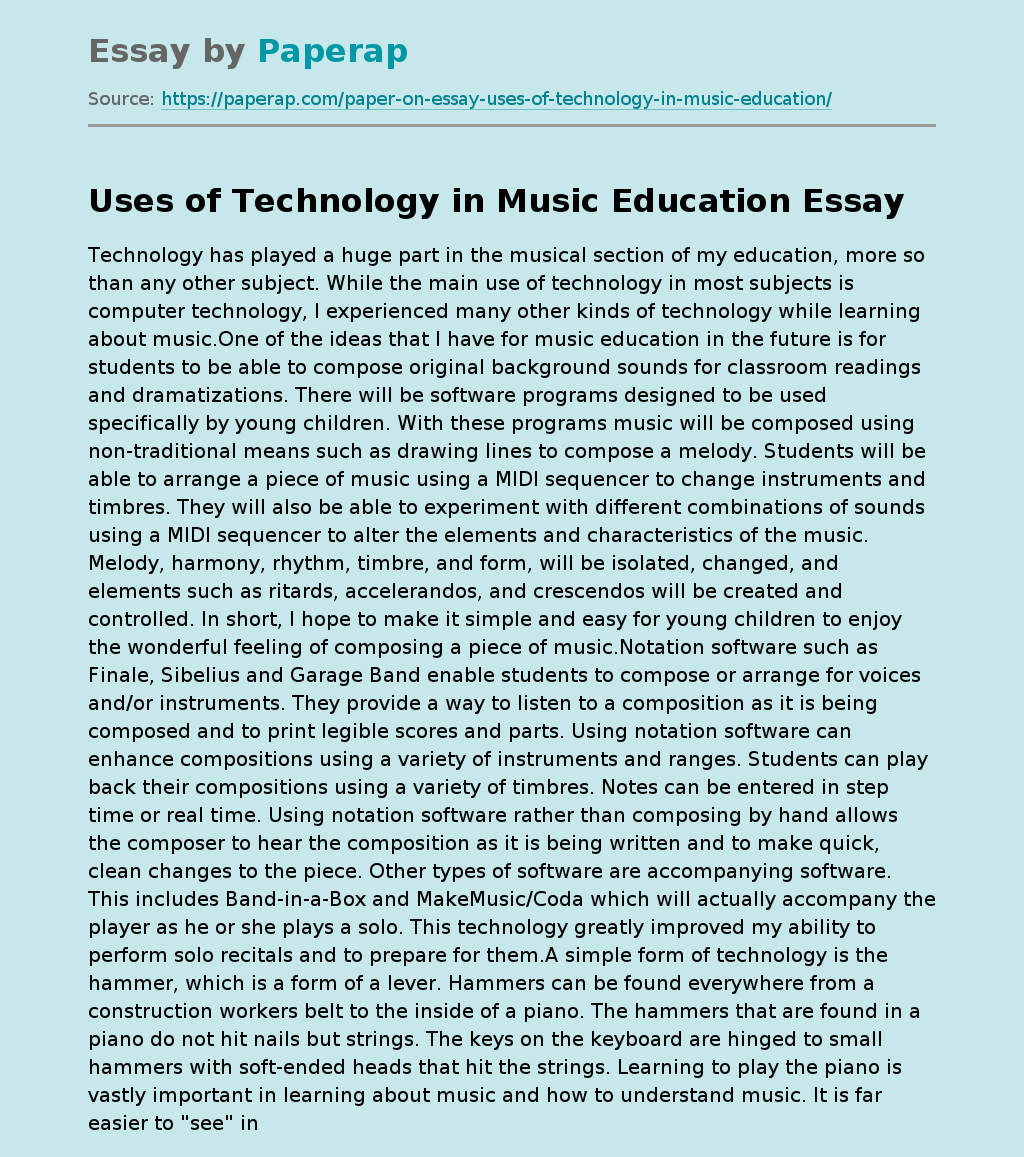Uses of Technology in Music Education
Technology has played a huge part in the musical section of my education, more so than any other subject. While the main use of technology in most subjects is computer technology, I experienced many other kinds of technology while learning about music.
One of the ideas that I have for music education in the future is for students to be able to compose original background sounds for classroom readings and dramatizations. There will be software programs designed to be used specifically by young children.
With these programs music will be composed using non-traditional means such as drawing lines to compose a melody. Students will be able to arrange a piece of music using a MIDI sequencer to change instruments and timbres. They will also be able to experiment with different combinations of sounds using a MIDI sequencer to alter the elements and characteristics of the music.
Melody, harmony, rhythm, timbre, and form, will be isolated, changed, and elements such as ritards, accelerandos, and crescendos will be created and controlled.
In short, I hope to make it simple and easy for young children to enjoy the wonderful feeling of composing a piece of music.Notation software such as Finale, Sibelius and Garage Band enable students to compose or arrange for voices and/or instruments. They provide a way to listen to a composition as it is being composed and to print legible scores and parts.
Using notation software can enhance compositions using a variety of instruments and ranges. Students can play back their compositions using a variety of timbres.
Notes can be entered in step time or real time. Using notation software rather than composing by hand allows the composer to hear the composition as it is being written and to make quick, clean changes to the piece. Other types of software are accompanying software. This includes Band-in-a-Box and MakeMusic/Coda which will actually accompany the player as he or she plays a solo. This technology greatly improved my ability to perform solo recitals and to prepare for them.
A simple form of technology is the hammer, which is a form of a lever. Hammers can be found everywhere from a construction workers belt to the inside of a piano. The hammers that are found in a piano do not hit nails but strings. The keys on the keyboard are hinged to small hammers with soft-ended heads that hit the strings. Learning to play the piano is vastly important in learning about music and how to understand music. It is far easier to “see” intervals on a piano keyboard than it is on any other instrument.
The teacher has an easier time using a keyboard to show an interval than they would playing it on an instrument because the keyboard not only allows the interval to be “seen” but also heard.A new piece of technology that also proves to be a very effective in teaching music is an iPod. iPods help the public by condensing DVD and CD collections. They also help music teachers when the teacher is giving a listening example. My personal experience with an iPod being used as a teaching tool was in an ethnomusicology class in high school.
My teacher was able to quickly and easily transition between pieces and songs that we as a class had to analyze and compare. When comparing two pieces, it is easiest to compare them if they are heard in quick succession, which an iPod allows to happen.If the same thing were to be attempted using two different CDs, then it would be much harder to compare the two pieces because of a much larger gap between the two listenings. The iPod also helps with finding songs more quickly.
It takes much less time to find a song on an iPod where you can search alphabetically by title, artist, composer, album, or by play list. This process takes much more time when searching through a CD collection. Because my teacher was able to use an iPod rather than CDs, the class was much more efficient and insightful.One of the most helpful tools a music teacher can use when teaching students how to play a piece correctly is a metronome. This tool is used to keep a beat at a steady tempo and the more expensive ones can also sub-divide the beat into any number of parts and even serve as a tuner as well. Metronomes started out as non-electric, wound up boxes that had a pendulum with a weight at the top. Instead of swinging back and forth with the weight situated at the bottom of the pendulum, a metronome’s pendulum would rock back and forth.
The lower the weight was placed, the faster the tempo. These metronomes were not as helpful as modern metronomes because of their inability to sub-divide the beat. Young musicians often find it VERY hard to keep a steady tempo so a metronome is the perfect tool for a music teacher to use to improve this skill.Technology obviously has made teaching and learning about music much easier. I hope that in the future, I will be able to help advance more music technology and further improve the ease with which music is taught.
Uses of Technology in Music Education. (2019, Jun 20). Retrieved from https://paperap.com/paper-on-essay-uses-of-technology-in-music-education/

